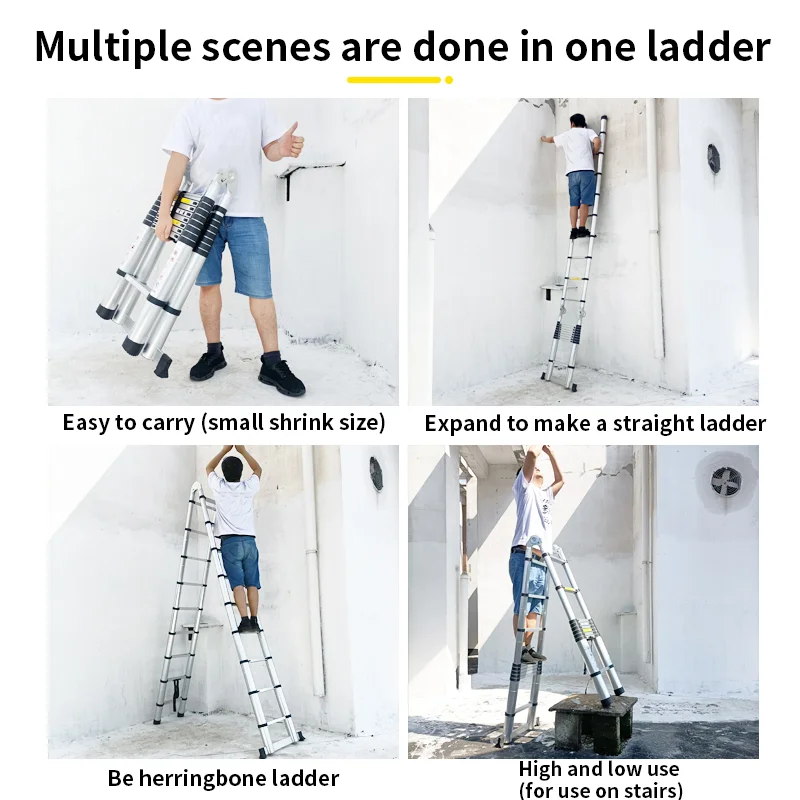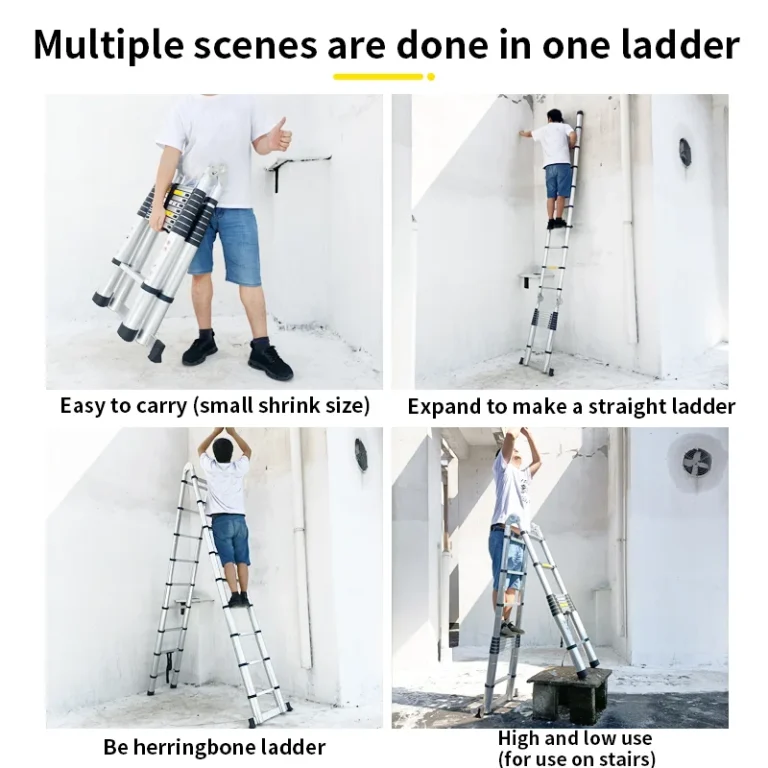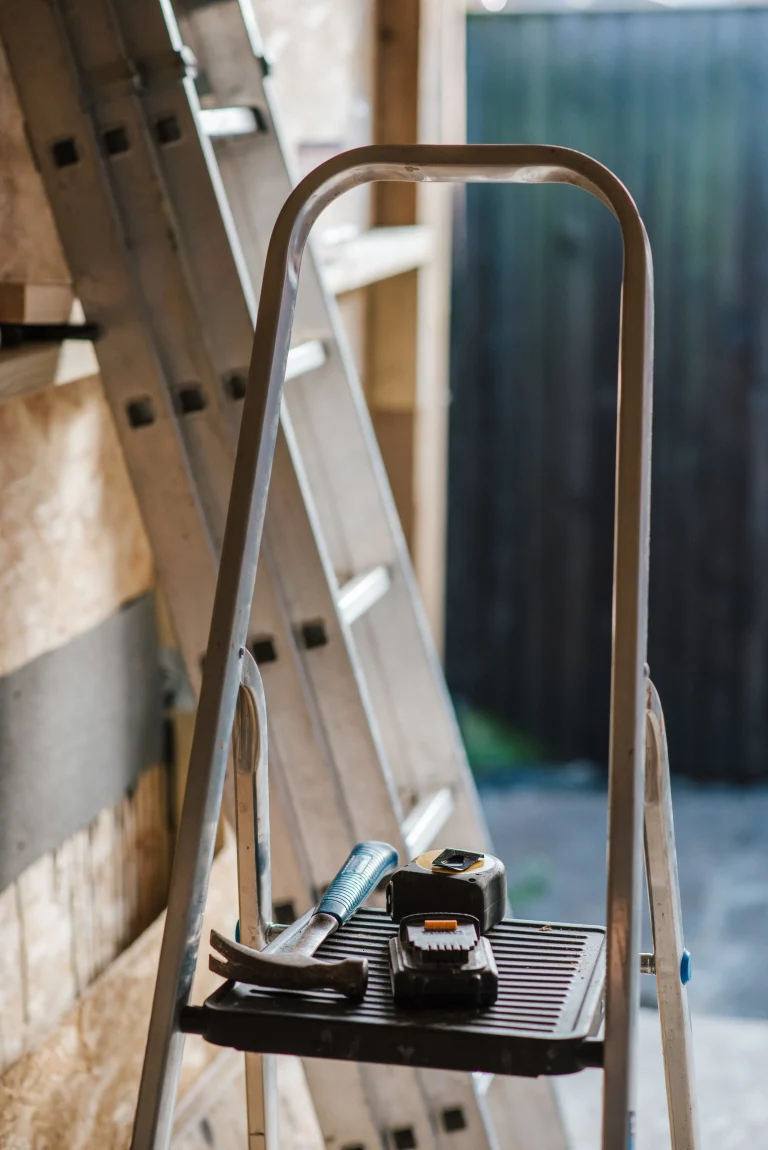Telescopic ladders are super cool for working on stairs. They’ve got adjustable legs and grippy features that make them awesome. This guide shows you how to set up, place, and take care of these handy ladders to stay safe on uneven spots like stairs. JADDUO’s ladders are built tough to make your jobs easy and safe.
What Makes Multipurpose Telescopic Ladders Ideal for Stair Use?
Which Features Make a Great Telescopic Ladder?
A multipurpose telescopic ladder is perfect for all kinds of places, especially tricky staircases. They can change height, have legs that adjust on their own, and fold up small for storage. These ladders are usually made from light but strong aluminum alloy. This stuff is tough, doesn’t rust, and is good for the planet since it can be recycled.
Lots of models have wide, grippy steps. These make it safer to stand on, especially on uneven stairs. Wide steps spread your weight out, so your feet don’t get sore during long jobs.
Why Are Telescopic Ladders Safer on Stairs Than Regular Ones?
Regular ladders aren’t great for stairs because they’re stiff and don’t adjust. Telescopic ladders are different. They let you tweak each leg separately to match the height of different steps. This keeps the ladder steady.
Slipping is a big problem on stairs. Telescopic ladders fix this with grippy feet and stabilizer bars that keep them from sliding around.
How Does JADDUO Make Ladders Safer?
Looking for a ladder that’s awesome for stairs? Check out JADDUO’s Aluminum 2 IN 1 Multipurpose Telescopic Ladder Portable A Frame Ladders. It’s got A-frame steadiness and can adjust for stairs. It has strong joints, solid locks, and folds up small to fit in tight spots.
JADDUO is a big deal in Yongkang, China’s hardware hub. They sell ladders in over 50 countries. Their stuff meets EN131 standards, so you know it’s made with top-notch materials and super strict quality checks.
How Should You Evaluate Stair Conditions Before Setting Up a Ladder?
What Should You Check About Stairs?
Before putting a ladder on stairs, look at the steps’ size, height, and slant. Make sure each step is strong enough to hold weight without bending or wobbling. Don’t set up on narrow or broken steps.
Put the ladder on solid, flat ground. Stay away from uneven or slippery spots. If the stairs are tiled or wooden, check for water or oil that could make it slick.
What Dangers Are Common on Stairs?
Watch out for these sneaky problems:
- Loose rugs or carpets.
- Slippery tiles.
- Messy steps with stuff on them.
- Bad lighting.
Losing balance on empty or slick steps is a top reason for falls. Clear the area before you start.
Why Is Weight Spread Important on Stairs?
Stairs make one side of the ladder higher than the other. This can mess up balance and stress the ladder’s joints, making it tip. A good ladder spreads weight evenly across its parts, keeping it steady and safe.
How Can You Configure a Multipurpose Telescopic Ladder Properly for Stair Use?
How Do You Set the Height and Angle Right?
Use the ladder’s locks to adjust each leg separately until both feet sit firmly on different steps. Keep the ladder at a 75-degree angle with the ground (1 meter out for every 4 meters up).
Why Are Adjustable Legs a Big Deal for Stairs?
Stairs have uneven heights. Adjustable legs let you keep the ladder balanced without using unsafe stuff like bricks or blocks to prop it up. Some fancy models even have level indicators to make sure it’s lined up perfectly.
What Safety Checks Should You Do Before Climbing?
Always check these things:
- All locks are clicked in tight.
- Rubber feet aren’t worn out.
- Stabilizer bars are hooked up.
Make sure steps, joints, and locks are secure. For extra safety on stairs, pick ladders with wide, grippy steps made for uneven ground.
What Are Best Practices When Operating Ladders Safely on Stairs?
How Can You Keep Three Points of Contact?
Always keep two hands and one foot—or two feet and one hand—on the ladder while going up or down. This stops you from slipping if you lose balance or something bumps you.
Which Body Moves Prevent Accidents?
Stay in the middle of the ladder. Don’t lean too far to the side or stretch past your shoulders. Go down slowly, facing the ladder. Don’t climb backward or twist your body while moving.
What Weight Limits Should You Stick To?
Most good telescopic ladders hold up to 150kg, including you and your tools. Don’t carry heavy stuff in your hands while climbing—use a tool belt or rope to pull things up.
Can Accessories Make Ladders Safer on Stairs?
What Do Stabilizer Bars and Grippy Feet Do?
Stabilizer bars make the ladder stiffer side-to-side. Grippy rubber feet keep it from sliding, even on shiny stone steps. These are super important for the weird angles you get on stairs.
When Should You Use Platform Attachments?
For long jobs like painting stairwell walls or hanging lights, platform attachments give you a flat spot to stand. They make you less tired and let you use both hands for tools, making work safer and faster.
How Do You Maintain Your Telescopic Ladder After Stair Use?
What Checks Keep Your Ladder Trusty?
Check joints every month for wear, like loose rivets or bent parts. Make sure bolts are tight. Replace any bent bits right away. Ensure lock pins slide in easy without forcing them—that means they’re clean and oiled.
How Should You Clean and Oil Moving Parts?
Wipe the ladder with a dry cloth after each use to get rid of dirt or water. Put a little oil on hinges once a month if you use it outside a lot. This keeps things moving smoothly.
Where Should You Store Your Ladder?
Keep it upright in a dry spot, away from sun or rain. Use straps to keep telescopic ladders folded tight. Don’t let it unfold by accident—it saves space and stays safe.
Why Choose JADDUO for Reliable Telescopic Ladders for Stair Use?
JADDUO’s been making top-notch ladders since 2015. They ship over 300,000 ladders a year to more than 50 countries, like North America and Europe. Their ladders meet tough standards like EN131, ANSI A14, CE, GS, and RoHS.
JADDUO keeps things safe and smart with wide, non-slip steps (up to 78mm), strong aluminum alloy tubes that hold 150kg or more, and designs perfect for tricky spots like stairs.
FAQs
Q1. Can Any Telescopic Ladder Work Safely on Stairs?
A: Nope, you need one with legs that adjust on their own to stay steady on uneven stairs.
Q2. What’s the Best Angle for a Straight Telescopic Ladder?
A: Keep it at a 75-degree angle—about 1 meter out for every 4 meters up.
Q3. How Often Should I Check My Telescopic Ladder for Stair Use?
A: Look it over before every use. Do a big check monthly for rivets, locks, rubber feet, and oiling needs.
Q4: What should I do if the ladder is too heavy?
A: All of our 6.5m-8.5m single telescopic ladders are equipped with balance bars/stabilizer bars and wheels, which can better solve the problem of moving heavy ladders at work and improve work efficiency. For the Multipurpose 2 IN ladder, we can also add these accessories if needed. Please communicate with our sales staff.










